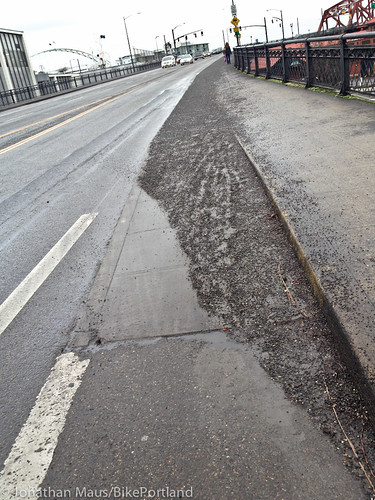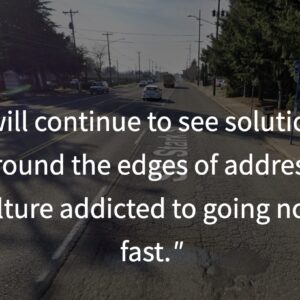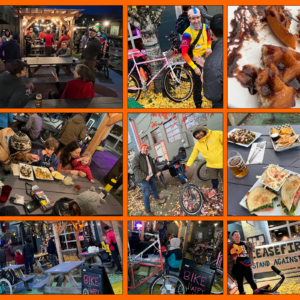It’s been a challenging week transportation-wise here in Portland. First we were hit by snow and strong winds, then freezing rain, then a blanket of ice. After that, we had to trudge through tricky slush-piles. Now, thankfully, the weather is getting back to normal; but one last challenge remains: gravel.
“It’s like pouring rice over your floor. If you sweep it up, you’re still going to find kernels later.”
— Diane Dulken, PBOT
All three of the transportation agencies in the Portland area — the Portland Bureau of Transportation (PBOT), the Oregon Department of Transportation (ODOT) and Multnomah County — use sand or gravel to improve traction when snow and ice are on the roads (we don’t use salt around these parts due to its environmental impacts). That means when the snow and ice melts, the gravel remains. And since auto and truck tires automatically sweep the tiny little rocks out of standard vehicle lanes, it all ends up in the shoulders, bike lanes, sidewalks and paths that people on bikes rely on.
We contacted all three agencies to find out more about how much gravel they laid down, and more importantly, how and when they plan to pick it all up.
Diane Dulken on PBOT’s communications team said it “will be a several week process” before they can pick up the 1,000 cubic yards (about as much as 1,000 pick-up trucks full) of gravel they laid down. “It’s like pouring rice over your floor. If you sweep it up, you’re still going to find kernels later,” she said on the phone today.
The last time Portland got this much snow was back in the big storm of 2008. Dulken said it took their crews 6-8 weeks to pick up all the gravel after that storm; but this time around PBOT hopes to shorten that timeframe. City sweeper crews will work in pairs and Dulken said it will take more than one pass to get it all. And yes, they do plan to recycle it once it’s all picked up.
Dulken said crews started the process yesterday by making their first passes along the N Williams/Vancouver couplet. Today they’re remaining in north Portland with daytime crews focused on N Lombard, Willamette, and Rosa Parks Way. Night crews will tackle the Central Business District and bridge approaches* first, a.k.a., “The places that have the most impact on people biking, walking, taking transit, and driving,” said Dulken.
(*PBOT is responsible for just the approaches to bridges while Multnomah County is responsible for bridge decks and paths.)
In addition to sweepers, this year PBOT is experimenting with crews that will try to flush the gravel into the gutter and off of sidewalks with water hoses. PBOT doesn’t apply gravel directly onto the sidewalks, but it ends up there after plowed snow melts away.
As we roll through these next couple of weeks, Dulken said everyone should be advised and go slower, especially on downhills. (To report an especially bad spot, call (503) 823-1700.)
Multnomah County’s road maintenance department is much smaller than PBOT or ODOT; but they still have a gravel pick-up plan. Spokesman Mike Pullen said today that the biggest hot spot on their list right now is the Burnside Bridge, which, unlike other downtown bridges, has a curbside bike lane that’s not separated from the standard vehicle lanes. Pullen added that County maintenance crews have already swept several sections of Skyline Blvd but they haven’t started to clean bridges yet.
“We’re very aware of the issues this sand has for bicyclists.”
— Don Hamilton, ODOT Region 1
“First, our crews have to get rested up,” is what ODOT Public Information Officer Don Hamilton told us when we asked about gravel pick-up today. With many more lane miles to take care of than PBOT, ODOT’s Region 1 maintenance teams are worn out from the past week. Hamilton said they laid down 8,000 cubic yards of gravel since Thursday — that’s eight times as much as PBOT.
Before they can start picking up all that gravel, Hamilton said, crews will go out and clean up general storm debris. “Things like car chains, truck chains, and car parts,” Hamilton said, referring to the array of detritus a storm leaves behind. Similar to PBOT, Hamilton made it clear that the gravel won’t be gone anytime soon. “Sweeping is not a quick process,” he said, “It takes many, many times over to get it right.” They’ll do most of their work at night and Hamilton said we can expect the gravel to be mostly gone in 1-2 weeks.
With such a broad management area, Hamilton said each local maintenance crew makes their own decisions about where to send sweepers. The public can help direct their attention to hotspots by reporting them to the district maintenance office at (971) 673-6200.
Hamilton also added that sweepers will focus on getting the gravel out of shoulders and bike lanes. “We’re very aware of the issues this sand has for bicyclists,” he said, “We’re trying to make things clean for them.”
— Read all our 2014 Winter Storm coverage here.







Thanks for reading.
BikePortland has served this community with independent community journalism since 2005. We rely on subscriptions from readers like you to survive. Your financial support is vital in keeping this valuable resource alive and well.
Please subscribe today to strengthen and expand our work.
If that stretch of NW Everett in the “teens” has never spooked me before, it certainly made me nervous today.
That picture is crazy. They are risking getting hit because they don’t want to ride on gravel. (Just like that jack@ss years ago who was doing the same on the hawthorne bridge, got buzzed by a bus, then jumped in front of the bus cursing out the bus dirver, then got punched out by a person riding that bus).
I don’t understand why so many people commute with skinny tires…get a bike that at least will fit some cyclocross knobbies…and even better mountain bike tires. Then you can just ride ride through the gravel. Use slicks during the nice months…and knobbies the rest of the year.
pretty sure it’s not about traction, but flats. ALL bike tires except for ones with protective bands are vulnerable to flats from this sharp debris.
I can’t stand having skinny tires on my commuting bikes. Even without gravel, it makes for a rough ride.
Cue up the poster who will claim they run 700×23’s at 110 PSI and run just fine under all conditions.
I run 700 c’s at 110 psi under…wait a minute.
even if you don’t leave the house you still risk getting hit by a motor vehicle…
you can’t just say to get knobby tires… they cause a lot of extra drag… and they still slip on gravel… you might as well just be telling us to get a car…
if the city wants people to ride their bikes then they need to make it a decent experience…
“jack@ss…who was doing the same on the hawthorne bridge”
ironically, the last serious accident on the hawthorne bridge occurred in that brand-spanking new protected bike lane. you know…the one that created a world-class bone-crunching blind right hook.
“I don’t understand why so many people commute with skinny tires”
because when ridden on pavement cross tires/knobbies are boat anchors, have poor rolling resistance, have poor grip, and corner terribly.
Matt F, a person operating a bike is totally allowed use of the full lane there as there is a hazard in the bike lane (I don’t care if you have knobby tires either – gravel on pavement is a slide hazard on two wheels). Curious about your aggro attitude about riders asserting their rights.
Sorry my comment went too far.
Let me clarify please…I think it’s a good idea to put on wider, tougher tires (in my case cyclocross tires) when there is bad weather (or after bad weather when there is gravel in the lanes). So you can ride through obstacles without having to take the lane or ride on the edge of the lane on faster moving, potentially dangerous roads/situations.
I’m all for taking the lane when it makes you safer as a rider but often it’s not a good idea. And being half way between (not in the bike lane but not taking the lane either) which most people do is the worst option.
Agreed! every morning i step outside and evaluate the weather,wind direction, precipitation, barometric pressure, dew point, and inspect the road surface. upon concluding my inspection i go about the task of selecting the perfect tire for that day’s commute. for instance today i selected a set of french handmade tubulars that were put together for the express purpose of tackling the famous pave of the Paris-Roubaix. I had them mounted by my mechanic and set out on my jaunt to the workplace. it was a most enjoyable ride. As semi trucks streamed past at 45 mph a mere 3 feet from my fragile body i thought “ha! if it wasn’t for the superior traction provided me by this fine french craftsmanship i am speeding along upon, i might lose my bearing on this gravel and end up beneath that multi-ton vessel!” luckily i am no cycling novice, i am a COMMUTEUR!
I’m a lot more worried about punctures from the broken glass and other sharp objects that pervade recycled gravel than I am about going down because of the gravel.
matt f
I have 700X45 Schwalbe Delta cruisers and I flatted on the gravel. I also have full fenders and chain guard and I has covered in grit.
Seems like a lot of work so that people could drive around in the snow for three days.
“It’s like pouring rice over your floor. If you sweep it up, you’re still going to find kernels later”
But you still sweep it up. You might even get out the dustbuster. But you sure as hell don’t just leave it all over the floor.
That’s an excellent point. Someone should look into whether there are plans to remove those rocks, and write a story about it.
Gravel grinders are really popular right now.
Yes, but there is a world of difference between riding a gravel road and riding a paved road with a thin layer of gravel on it.
For the win.
Posted in the weather update thread: I’m happy PBOT stays off my neighborhood greenways. After the thaw my commute is beautiful bare pavement – until I get to an arterial that has been “sanded” by PBOT.
Also..
“First, our crews have to get rested up,” is what ODOT Public Information Officer Don Hamilton told us when we asked about gravel pick-up today. With many more lane miles to take care of than PBOT, ODOT’s Region 1 maintenance teams are worn out from the past week.”
Seriously? Worn out? Cry me a river, maybe they should have hired people who are physically capable of performing their jobs in the first place. I didn’t get a day off last week, and despite that I’m expected to show up at work this week. Imagine that. It’s called doing your job.
Most ODOT crews were likely working significant overtime. You don’t want people who operate heavy machinery on public highways to just keep on working if they’re mentally and physically exhausted – it’s unsafe for them and everyone else.
fair enough, but comes off as super defensive, and not a good way to do public communications.
It sounded straightforward and sensible to me.
the other simple answer (though it’s nice to give a more thorough explanation) though this one is pretty straight-forward is. . . they’re union. Depending on their contract and staffing, they’re only allowed to work a certain amount of hours at a time and if you max out the hrs, you’re stuck. No staff, no more overtime availability, you just have to wait it out until their regularly scheduled program. It protects their health and welfare. These are human beings, not machines. I am sure that they worked as much as they could during the weather. (Heck if overtime or bad weather pay is offered or available then I am sure people jumped on it.) However, it’s probably not an urgent crisis situation now, so afterwards, clean-up is regular time so has to be regularly scheduled time. Treat them like human beings.
During the weekend, where I work (also union, a homeless shelter) was having staffing issues, and the people that could stay were getting overtime despite our union contract not to work more than 12hrs in a day. Sleeping at work, etc. We had to keep the place running despite the weather.
You couldn’t invent a better example of someone sitting on their butt complaining about people who are busting theirs…
You couldn’t invent it but you sure as hell can complain about it. Keep up the whine, Portlandia.
I work at PDOT Maintenance Bureau. We worked 12 on 12 off for four days during the last event. Half of the day shift crew goes to nights, then back to days with one day off between schedule changes. In my job I drive a 50,000lbs 12yrd dump/plow truck around 10 1/2 hrs during a shift plowing some of the most treacherous roads in Portland; Germantown, Skyline, Cornell, Thompson, Barnes, ect. All I can say is Germantown will give you a healthy respect for gravity in a vehicle of that size with no ice. Doing a good/safe job takes intense concentration, and is exhausting. I have worked 11 days with no days off. Not sure what type of job you do, but OSHA says road work is one of the most dangerous. So a couple days rest is needed. I’m not whining, just tired.
On the gravel cleanup, we do our best to get it up as fast as we can. Clean, safe bike lanes are important to a lot of us at PBOT. The city is not giving us the hours they did in 2008 to clean it up so it will take longer. Instead of 70hrs a week for two weeks, we will work 50hrs. That will mean about 200 less curb miles less per week, per shift. That’s a lot of gavel staying on the roads until the next time we regularly sweep that street. I’m sure happy I have Kevlar 2.35’s with Slime tubes and lots of XC experience right now, cornering can be dicey at speed.
So I encourage everyone to call 823-1700 and report your commute route. Also call Commissioner Novak at 823-4000, and let him know you wold like bike transit routes cleaned up now, not when the get around to it.
The squeaky wheel gets the grease at the City.
…and ODOT/ PBOT/ other cities…please do not forget to include attached sidewalks next to these heavily gravelled areas. (One more reason why not to spec and install narrow attached sidewalk along higher speed arterials and highways.
We are will be hosing the gravel off the main the sidewalks. There is a lot of sidewalk in Portland. Call 823-1700 and ask to have sidewalks important to you cleaned. Note: The City uses a trackit system. Ask for your trackit # and you can follow up quickly on the progress @portlandonline.gov
I don’t want to use wide tires. They roll slow and are heavy & just generally suck. Me and my 23s and 25s get me from A to B much faster than your 32s and 2.35″s.
Actually not…http://janheine.wordpress.com/2014/01/05/wide-and-fast-tires/
at the same tire pressure wider tires have better rolling resistance but who runs their 23s at 80 psi.
Higher pressure does not make tires faster either; actually on anything but a perfectly smooth surface the up and down vibration caused by high pressure tires causes suspension losses as your body vibrates up and down. This absorbs energy and makes you slower for the same energy output. This is very counter intuitive because hard tires “feel” faster, but in fact careful testing shows the opposite.
For those that ride in Washington County, this statement came from the WashCo Land Use and Transportation weekly update:
“One of our next tasks will be sweeping up the 2,000 tons of sanding rock used to provide traction on icy roads. We’re also gearing up to respond to upcoming weather events. The National Weather Service issued a wind advisory from this evening through tomorrow morning. With lots of rain and melting snow, we could see high water on some county roadways over the next several days. And there’s a hint of more snow in the forecast for this weekend. County crews will continue to provide 24-hour storm response and cleanup throughout this week. “
“I don’t want to use [tires that work in real world conditions]” <– FTFY.
I would agree that knobby MTB tires are pretty slow on clear pavement (as I was reminded this weekend when I rode it all over town), but GOOD 'cross semislicks are a world away from MTB tires. I find the difference in speed between fragile, special-purpose 700×23 racing slicks and my SpeedMaxes at 90-100psi to be pretty marginal (oh, and I can still corner at nearly twice the speed of cars, so how much more cornering ability do you need??).
Seems like a princess-and-the-pea(gravel) difference to me. A worthwhile price for being able to ride in the real Portland of chuckholes, unpaved side streets (all over the place on certain variants of my West Hills commute), rail tracks, Hawthorne Bridge rumble strips and (OMG!) tiny bits of gravel in the road.
Speedmaxes don’t corner on tarmac very well, IME. To each his own, however.
WTB All Terrain in 32 is probably my favorite budget winter tire. Pretty tight, short knobs so corner OK on tarmac, do pretty well on gravel, a little noisy on wet pavement, however.
Agreed, SpeedMaxes aren’t the best at cornering. I find them adequate, but I should have been more clear that I use them in back, but I actually use other tires in front with a more rounded profile that corner better. Maxxis OverDrive and Schwalbe Marathon Winter are a couple of my current favorites, and I also like my old Maxxis WormDrives up front in the warmer months. Ready for any unpaved street Portland can throw at me, including those in Forest Park.
To your point about to each his own, I found the WTB All Terrains to be among the sketchiest tires I’ve ever used on wet pavement.
That’s because drivers operate well below their car’s limit, not because the absolute cornering limit of bikes is higher than cars (it’s lower).
Well, and narrower vehicles have more latitude to “straighten the curves”, as Bo and Luke might say… Now if only I could flatten the hills…
I suppose you could just fly over the valleys, but my bike is more ‘generally’ than General Lee.
Overtime is an issue. They already racked up quite a bill working the storm. They need to work as efficiently as they can without overtime.
While I realize that NW Washington didn’t get hit nearly as bad as us – my mom in Everett, WA mentioned that they sanded her streets and. . . it’s already cleaned up. However, she states it could have something to do with the influence of all the Boeing employees that live nearby. (Public road, though.)
You know you can just ride through that stuff, right? Even on road tires, it’s not going to kill you. Just relax your grip on the bars and let the front end do what it wants. I’d much rather do that than take the lane unnecessarily, irritating fellow road users.
ride it or take lane just watch if you need to stop quick.
I lost a tube this morning to the gravel on Barbur (Gatorskins 28 @ 90psi, BTW). I’d love to see that get swept up pretty soon; taking the lane when the lane is full of traffic going 65 in a 45 zone is fairly terrifying.
…and another today. Two in two days, and I tried hard to stay clear of heavy gravel this morning. Ended up with a rear tire going flat while crossing the bike-lane-free bridge on Barbur. That’s not an experience I’d recommend.
Lower your tire pressure to 70; you will go just as fast with a more comfortable ride and less flats.
I gave it a try. I got one ride in safely, but a flat (a third one in four day’s riding) the next day.
I’m out. That’s it. I’m driving til they clean that s#!+ up. But at least I’ll contact the city and let them know…maybe I’ll write a note on the three blown tubes and mail them in.
It’s like riding Dirty 30 all around town.
It is my understanding that one of the worst contaminants for salmon health is grit from road run-off. Is there any chance the endangered species act could compel some clean up (also some compost bags at inlets seem like a good idea). 100 cuyds of fine gravel seems like a massive erosion problem. I am not saying that the gravel use was unwarranted, but I do believe the laissez-faire approach to clean-up is inappropriate
You a re correct about the contaminants; see link: http://www.worldsweeper.com/naPSa/AmyEssay.html .
Major cities like Minneapolis, and San Diego have increased their street sweeping program in the last decade which has significantly reduced the amount of contaminants, (oils, chemicals, and metals), getting to their storm water systems and wetlands. Portland has significantly reduced it’s sweeping program. There are only three sweepers on days, five on nights.
It has always amazed me that in such an environmentally conscious and forward city as Portland, we have let the city commissioner’s chop this important service to nothing, as well as the other core services, and give away tens of millions of dollars of Portland taxpayer dollars that we can’t spare to entities that are not city bureaus.
Street sweeping should funded with Environmental Services dollars. Then there would be 30 or 40 sweepers out cleaning this stuff up, and zero overtime needed to do it.
I hate to be insensitive, but this is all part of normal roadway treatment all over the place. My commutes take me through sand and gravel all of the time and I’m just running a Maxxis Overdrive at a little lower pressure. Sure my bike is full of grit, but that’s what a visit to the local co-op (Boise Bicycle Project) or my home shop is for. I appreciate what the road departments do for us when the roads are utter shite…it keeps the cars where they are supposed to be. I’ll put up with the dirty ride for a while in the winter. Now, about our new protected lane that is full of car parts, boards and other detritus, I WILL complain about that!
The City can’t afford to sweep it up, or new sidewalks, but “City Commissioner Steve Novick has spent the past two months saying Portland can’t find the money for basic transportation services such as streets and sidewalks.
But Novick’s city budget requests show he’s also trying to funnel more than a half-million dollars to a new mass transit project that would mostly serve people living outside the city limits.
No, it’s not the Columbia River Crossing or Portland-Milwaukie Light Rail.
Novick has requested $650,000 to study the possibility of building a new light-rail line through Southwest Portland to Tualatin, a project that could include drilling a second train tunnel through the West Hills. ”
http://www.wweek.com/portland/article-21980-tunnel_vision.html
On my commute to Hillsboro and back yesterday, I wore a letter-size sign on my lower back – printed landscape style “100 PSI tires, bike lane heavily graveled”. No one tooted at me or passed me closely.
“each local maintenance crew makes their own decisions about where to send sweepers.”
And then we wonder why it takes weeks to get the gravel cleaned up?! How much of each day is spent making the decision? What guidelines help them determine where to sweep? What do the supervisors do if the crews decide what to do? I wonder how many on the crew are bicyclists and even understand what the issue is. This seems like a rather loosely run outfit. Or was that a typo?
The crews at PDOT are given their daily assignments by their supervisors. We report when we see things that should be taken care of, and the supervisors say yes or no. There is a map the City has created prioritizing the streets to be swept. Main bike lanes are on that map. We mark off daily what gets done. If a trackit comes in this time of year, it will be grouped into work being done in that area, (Unless it is a threat to public safety, then we do it now).
There is over 4,800 lane miles in Portland. There are curbs with gavel on both sides of a lot of these lanes. We have seven sweeper operators total. We sweep in tandem to get the most debris we can in one pass. We are only sweeping five days a week. This will take some time to get done.
And by the way, we have a lot of people who ride and care about bike lanes. Even one of the day sweeper operators is a daily bike commuter. There are several daily bike commuters at the Maintenance Bureau. We definitely care about bike safety..
It is common after a storm locally (TX) to find drifts of sand in the bike lane every time it goes over a bridge (bridges get sanded first because they freeze faster, then get a second coat when the rest of the road gets it). I have seen several wipe outs and near wipe outs from people sliding the front tire in the sand.
Riding up SE 7th this afternoon I heard another cyclist comment “this gravel is terrible!” Upon seeing her billiard-smooth 700x23s, my unspoken response was, “no, your tires are terrible!”
I will admit. They do seem to be doing a better job of sweeping it up this time. I mean, it’s not all up by a long shot, but I can see the changes each day. So, thanks, PBOT.
Glad to see the PBOT sweepers on duty at all hours. As a motorcyclist, I have had multiple near catastrophes in the last week or so with the loose gravel, although it’s not so bad if I know it’s there.
Overuse of the modern word “challenge” vs. just admitting that something’s a hassle duly noted. Fake optimism is tiresome. Some things are just tough!